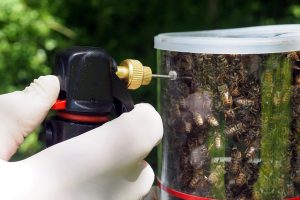Early signs of varroa – what happened next
Turlough, Vita Bee Health’s Guest Blogger, writes:
On 14 February 2019, I reported on the alarming discovery of a very early season heavy varroa drop-down rate (blogpost here).
Three colonies were immediately treated with Apistan and one was left for a short while to acquire a CO2 testing kit to gauge the level of infestation. That colony was then treated with Apistan.
So did the colonies recover?
They certainly did!
They produced a very good spring harvest and on 21 June they were again tested for varroa. The result — just one or two varroa per 200 nurse bees from each colony.
And to double-check, we gave two samples an alcohol wash as well (reluctantly because, unlike the CO2 test, the alcohol kills the bees). That revealed only one more varroa .
Clearly Apistan is still working well in this part of the world.
Research just published this week gives a clue as to why the colony was infested over winter after being remarkably clear of varroa in the autumn. Professor Tom Seeley and David Peck think that late surges in varroa result from healthy colonies robbing varroa-infested colonies and bringing the mites home as passengers.

